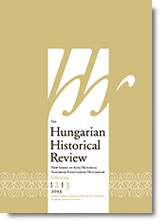The Lost Deportations and the Lost People of Kunmadaras: A Pogrom in Hungary, 1946
The Lost Deportations and the Lost People of Kunmadaras: A Pogrom in Hungary, 1946
Author(s): Péter AporSubject(s): History
Published by: Magyar Tudományos Akadémia Bölcsészettudományi Kutatóközpont Történettudományi Intézet
Summary/Abstract: The subject of this article is one of the scandals of postwar Hungarian politics and society: the anti-Semitic pogrom that took place on May 21, 1946 in the village of Kunmadaras. The Kunmadaras riot was part of a series of anti-Jewish atrocities that broke out in the summer of 1946 in the Hungarian countryside. These events, however, were comparable with similar violence against surviving and returning Jewish communities in East Central Europe, particularly in Poland and Slovakia. The scholarly literature so far has typically understood these events as the outcome of social discontent raised by economic hardships and mismanaged or openly abused and even generated by political ideologies, particularly Nazism and Communism. These descriptions rarely problematize the Jews as an obvious ethnic category and seldom ask questions concerning the ways peasant or local communities actually distanced their neighbors as “Jews” to be beaten. This article focuses on the everyday interaction through which ethnicity and ethnic identities were constructed in a village that, as the outcome of the events, was split between “Hungarians” and “Jews” in the summer of 1946. While taking the political implications into consideration, I argue that the pogrom was a consequence of the frames of traditional peasant culture, which were mobilized under the particular postwar social and political circumstances, and particularly of the culture of collective violence that was also present in the village of Kunmadaras. The second section of the article, however, concentrates on how politics abused the events during a subsequent trial and constructed a particular Hungarian version of the anti-Fascist myth without the Jewish victims themselves. As was the case all over Soviet-dominated East Central Europe, this myth built a certain level of legitimacy for Communist parties.
Journal: The Hungarian historical review : new series of Acta Historica Academiae Scientiarum Hungaricae
- Issue Year: 2/2013
- Issue No: 3
- Page Range: 566-604
- Page Count: 39
- Language: English

